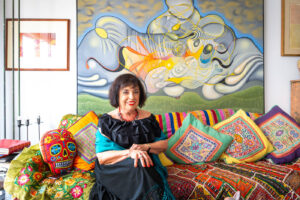| Zarela talks about food, flavor and family
02:57 PM CST on Friday, March 4, 2005 By BEATRIZ TERRAZAS / The Dallas Morning News She has written cookbooks, prepared meals for heads of state, launched a restaurant and hosted a TV cooking show. She has even broken horses. Yet for all her accomplishments, Zarela Mart’nez isn’t one to put on airs, a celebrity trait she dismisses as “ridiculous.” Everybody, be they queen or the poorest person in the world, “has something to offer,” says the petite New York restaurateur, who has earned first-name status in the food world. Her own acclaim has grown slowly during the years through determination and hard work. She started her food career in El Paso in the 1970s, and today her New York restaurant and cookbooks get rave reviews. She’s on a first-name basis with well-known Texas chefs such as Stephan Pyles and Joanne Bondy. Last year, she stepped outside the food world to launch a line of home furnishings — Zarela Casa — sold exclusively through Wal-Mart. Although she’s a success by anyone’s measure, her career began almost as a fluke; all her father ever wanted for her was to one day be a good wife. She grew up on both sides of the border. At the family cattle ranch in Sonora, “she was an excellent horsewoman,” says her mother, A’da Desouches, a cookbook author herself. Zarela graduated in the top 10 percent of her class from El Paso’s Loretto Academy. Complying with her father’s wishes, she went to finishing school in Guadalajara. But she also attended university classes that piqued her interest, including anatomy and mass communications. She eventually returned to El Paso, where she married and did social work for nine years. She finally launched a catering business as a way to help her family make ends meet. In 1983, after splitting from her husband, Zarela loaded her twin sons into her station wagon and drove east to New York. With little money, she vowed to make it on her own, even if it meant “selling burritos in Central Park.” She learned about the restaurant business while developing recipes for a Mexican restaurant, and by 1987, had her own eatery, Zarela Restaurant. Today it remains a vibrant place where her staff serves food from the interior of Mexico. One of her sons is an attorney. The other, Aar-n Sanchez, is a chef with his own New York restaurant, Paladar, and his own cookbook, La Comida del Barrio. He was co-host of the Food Network’s Melting Pot and is working to launch his own show on another network. Zarela will also be featured. In spite of her success, Zarela remains “a very gentle, kind woman,” says Joanne Bondy, chef at Dallas’ Ciudad restaurant. “And that’s always a surprise … to find someone who is as popular and as well-known as she is, to keep that level head.” We caught up with Zarela during her recent visit to Dallas for appearances at the Savor Dallas wine and food festival. Question: It’s quite a stretch between social work and chef. What inspired you to try food as a career? Answer: Actually, it’s a very sort of similar career, because food is about nurturing people and so is social work somehow. It’s sort of a caring profession. I was married to a widower with three kids, and then I got pregnant with twins and I needed to make extra money. So I started making cookies for people. Having grown up on a ranch, there wasn’t much to do, so our big entertainment was cooking. I used to cook at my mother’s side every day — food from all over. So I was already a very good cook. I just started with cookies, and I started making dinners for my sister, who was very rich and was entertaining a lot. Question: What is it about food that inspires you? Answer: One of the wonderful things about it is that it’s instant gratification. You feed people, and immediately you get wonderful feedback. But for me, there is no greater manifestation of a culture than its cuisine. My No. 1 passion in life is cultural anthropology. In all of my books and everything I’ve done, I always try to situate food in a cultural context. And what I love most about … my career, is that because of food, I have gotten to know my country. Because when you grow up on the border you have no idea who you are, or what the country is. You’re more associated with the United States and the Chicano culture than you are with Mexican culture. So it has allowed me to get to know the people, has allowed me to get to know the culture, the customs. And it’s endlessly fascinating. I’m constantly challenged. Question: Tell me about your philosophy of layering flavors in your recipes. Answer: We have a particular dish that’s … really not in my style now. But it’s one of the most popular dishes. It’s the chilaquiles that I’ve developed. And people always ask for that recipe. And I think, “You don’t understand how difficult it is to make.” First of all we boil the chicken with a lot of herbs. Then we shred it. Then we sautee it with onion, garlic, pepper and salt. Then we fry the chips. Then you add the cream; the cream has onions and cilantro. Then you have the tomatillo sauce, which you thicken with the tortilla, which adds another flavor. So when you taste it, it tastes like one thing first. And then you’re chewing and it tastes like another thing. And then you swallow it, and all the spices and everything sort of bloom in your mouth. So all of my food is designed like that. Question: There is nothing quite as sensory as eating. … But we Americans are so obsessed with food in a very different way. We’re obsessed with dieting, with food that won’t make us fat. We deny ourselves that sensory pleasure. Answer: Now that I’ve learned how to eat very well, I realize how much you can eat and not gain weight. But another one of my goals in life is … trying to reach the Mexican-American community and teach them how our traditional diet is very healthy and we should stick by it. The bane of society here is fast food. It’s disgusting. That’s why everybody’s getting so fat, because of all the processed food. Hydrogenated oil is like poison. Question: Are you saying we could still eat very well and … ? Answer: And not gain weight. I mean, you’d be amazed at how much I eat. I also exercise like crazy. But I eat very well. Question: What is your absolute favorite dish? Or do you have a favorite? Answer: I don’t know that I have an absolute favorite. But my favorite dish at the restaurant is this duck, which is with manchamanteles, which is technically one of the moles. It’s sort of like a fruit sauce. I tasted it in Aguaprieta [with] some friends of my parents who were from Chiapas. And when I tasted that dish, I realized that there was a whole other world of food that I didn’t know. She didn’t prepare it with duck. She prepared it with chicken and pork together. And at the restaurant we do it with a roasted duck. And it’s just fantastic. Question: We see a lot of Tex-Mex here. What are we missing as far as Mexican cooking goes? Answer: One of the things that people understand the least about Mexican food is that it is so regional. The food in Veracruz is completely different from the food of Oaxaca … and very different from Guerrero, let’s say, or Puebla, or Guadalajara. And I think that’s what you’re missing here. And actually it’s happening in New York, too. A lot of Mexican restaurants have opened. But most of them are doing a modern type of Mexican food, so they’re not traditional. I’ve always done this, the regional food, but now I’m stressing it a lot. … I’ve been doing monthly regional festivals. Like last month we did Guerrero, and this month we’re doing Sonora. And next month we’ll do the food of Puebla. Question: What would you be doing if not this? Answer: My life is so multifaceted already. I’d be doing what I’m doing. I’ve been working all my life toward this moment. I’ve had a very clear career path. First I wanted to have a catering business. Then I wanted to do a restaurant. Then I wanted to write a book. And I’ve written three, and I’ve started on my fourth. Then I wanted to do a TV series, and I’ve done that. And now I’m going to have another one. I wanted to have a line of products, totally “brand” my name. And here I am. What else can I do? That’s probably going to take the rest of my professional career. Question: Do you have a philosophy by which you live? Answer: The No. 1 philosophy is: Can I do something about it? … If I can, I will immediately get into action and do it, but if not, I just forget about it. The other part of my philosophy — and I tell this to my kids — I tell them the only big sin is to waste your talents. The greater amount of talent you have, the greater the responsibility you have to do something with it. And that’s always been the way that I’ve conducted my life. It leads to a lot of fulfillment. I’m completely fulfilled. |
| Zarela’s Ensalada de Camarón Shrimp Salad |
| Resources www.zarelades.cogrowconsulting.com Zarela Restaurant, 953 2nd Ave, New York, NY 10022. “Zarela’s Veracruz” by Zarela Mart’nez with Anne Mendelson (Houghton Mifflin, $20 paperback) “The Food and Life of Oaxaca: Traditional Recipes from Mexico’s Heart” by Zarela Mart’nez and Anne Mendelson (Wiley, $32.50 hardcover) Look for new offerings this fall in Zarela Casa home furnishings. The kitchen, bed and bath items are available at several area Wal-Marts, including: Wal-Mart Supercenter at 1521 N. Cockrell Hill Road, and Wal-Mart Supercenter at 7401 Samuell Blvd. |

